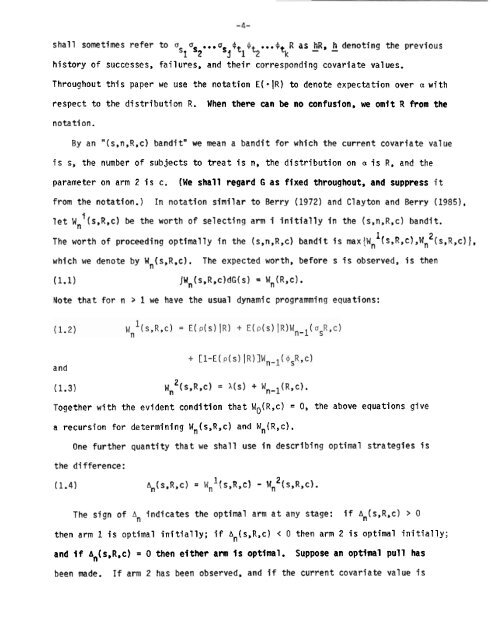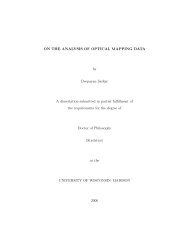Bernoulli bandits with covariates - Department of Statistics ...
Bernoulli bandits with covariates - Department of Statistics ...
Bernoulli bandits with covariates - Department of Statistics ...
You also want an ePaper? Increase the reach of your titles
YUMPU automatically turns print PDFs into web optimized ePapers that Google loves.
shall sometimes refer to oS as ... a + ...( R as hR, h denoting the previous<br />
1 2 y l t 2 tk - -<br />
history <strong>of</strong> successes, failures, and their corresponding covariate values,<br />
Throughout this paper we use the notation E( IR) to denote expectation over a <strong>with</strong><br />
respect to the distribution R. When there can be no confusion, we omit R from the<br />
notation.<br />
By an " (s,n ,R,c) bandit" we mean a bandit for which the current covarf a te value<br />
is s, the number <strong>of</strong> subjects to treat is n, the distribution on a is R, and the<br />
parameter on arm 2 is c.<br />
(We shall regard G as fixed throughout, and suppress it<br />
from the notation.) In notation similar to Berry (1972) and Clayton and Berry (19853,<br />
let w,~(s,R,c)<br />
be the worth <strong>of</strong> selecting arm i initially in the (s,n,~,c) bandit.<br />
I 2<br />
The worth <strong>of</strong> proceeding optimally in the (s,n,~,c) bandlt is rnaxt~, (s,R,c),~, (s,~,c) 1,<br />
which we denote by Wn(s,R,c).<br />
The expected worth, before s is observed, is then<br />
(1.1) jWn(s,R,c)dG(s) = W,(R,c).<br />
Note that for n 3 1 we have the usual dynamic programming equations:<br />
and<br />
(1.3)<br />
2<br />
w, (s,R,c) = i(s) + Wn-l(R,c).<br />
Together <strong>with</strong> the evident condjtlon that W~(R,C) = 0, the above equations give<br />
a recursion for determining W,<br />
(s,R,c) and W,(R,c).<br />
One further quantity that we shall use in describing optimal strategies is<br />
the difference:<br />
11.4)<br />
1 2<br />
dn(s,R,c) = (s,R,c) - Wn (s,R,c).<br />
The sign <strong>of</strong> An indicates the optimal arm at any stage: if bn(s,R,c) > 0<br />
then arm 1 is optimal initially; if \(s,R,c)<br />
< 0 then arm 2 is optimal initially;<br />
and if A ~ s,R,c) ( = 0 then either arm is optimal. Suppose an optimal pull has<br />
been made.<br />
If arm 2 has been observed, and if the current covariate vat ue f s
















